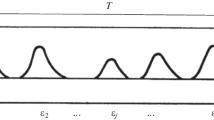Summary
Cosmic-rays muons of definite energy and direction of motion are expected to show a partial longitudinal polarization because of the falling energy spectrum of the parent pions. The general theory of muon polarization in π→ μ decay in flight is worked out, and applied to cyclotron as well as cosmic-ray experiments. Cosmic-ray muons are predicted to have a partial longitudinal polarization of about 23%. The theoryis also applied to the K →μ. decay. An experiment has been carried out to test the prediction for cosmic-ray muons. Decay electrons from muons stopped in an aluminum absorber are detected in identical scintillation counters placed symmetrically above and below the absorber. The delay and amplitude of each observed pulse have been measured, and used to sort out the μ+ → e+ decays from the μ- → e- and background contributions. The ratio of μ+ → e+ events detected in the upper and lower scintillators is 1.14 ± 0.07, as compared with a theoretical prediction of about 1.11. To test the symmetry of the apparatus the experiment has also been carried out with an absorber of salt, which is known to depolarize stopped muons almost completely. The upper to lower ratio is in this case 1.03 ± 0.06, to be compared with the theoreticallyexpected value of about 1.02. It is concluded that the various assumptions made in the theory of muon polarization in π → μ decay in flight are correct and that muons suffer negligible depolarization while losing 2 GeV energy in the atmosphere.
Riassunto
Per effetto dello spettro d’energia declinante dei pioni generatori si prevede che le particelle μ dei raggi cosmici di energia e direzione di moto definite abbiano polarizzazione longitudinale parziale. Si elabora la teoria generate della polarizzazione dei μ nei decadimenti π → μ in volo e la si applica alle esperienze, sia al ciclotrone sia coi raggi cosmici. Si prevede che i μ dei raggi cosmici siano polarizzati circa al 23%. La teoria si applica anche al decadimento K → μ. Si è eseguita un’esperienza per verificare la previsiono fatta pei μ dei raggi cosmici. Gli elettroni di decadimento dei μ arrestati in un assorbitore d’alluminio si rivelano in contatori a scintillazione identic i posti simmetricamente sopra e sotto l’assorbitore. Si sono inisurati il ritardo e l’ampiezza di ogni impulso osservato e si sono impiegati per separare i decadimenti μ- → e+ dai contributi dovuti ai μ- → e- ed al fondo. I1 rapporto degli eventi μ+ → e+ rivelati dagli scintillatori superiore e inferiore è 1.14 ± 0.07 contro una previsione teorica di circa 1.11. Per controllare la simmetria deU’apparecchio si è ripetuto 1’esperimento con un assorbitore di sale, che, notoriamente, depolarizza quasi completamente i muoni arrestati. I1 rapporto degli eventi superiori agli inferiori è in questo caso 1.03 ± 0.06 da confrontare colla previsione teorica di circa 1.02. Si conclude che le varie ipotesi fatte nella teoria della polarizzazione dei muoni nel decadimento π → μ in volo sono corrette e che i muoni subiscono una depolarizzazione trascurabile mentre perdono 2 GeV di energia nell’atmosfera.
Similar content being viewed by others
Notes
L. Lederman, V. L. Telegdi, M. Kaplon and others: Proceedings of the 1957 Rochester Conference, Chap. VII (New York, 1957); D. H. WilkLnson: Nuovo Cimento, 6, 516 (1957).
This question has been concurrently studied at M.I.T. with essentially the same results as ours and, in addition, with estimates of the muon depolarization in slowing down (S. Hayakawa: Phys. Rev., 108, 1533 (1957); G. W. Clark and J. Hersil: Phys. Rev., 108, 1538 (1957)). We are grateful to Professor CLARK for communicating the M.I.T. results to us before publication.
R. Levi-Setti, R. Garwin, A. Alihanian, and others: Proceedings of the Padua-Venice Conference (1957) (mimeographed edition).
It appears that the polarization of the positive muons is actually antiparallel (G. Culligan, S. C. F. Frank, J. R. Holt, J. C. Kluyver and T. Massam: Nature, 180, 751 (1957); T. D. Lee: Midwest Conference on Theoretical Physics, St. Louis (1958) (unpublished)). This does not affect our arguments, which are concerned with the degree of polarization, not its sense.
A good discussion of spin density (pseudo) four-vectors and related matters is given by H. A. Tolhoek: Rev. Mod. Phys., 28, 277 (1956).
For estimates of γ from the cosmic ray data, see G. Puppi: Progress in Cosmic Ray Physics, 3, 341 (Amsterdam, 1956).
C. A. Coombes, B. Cork, W. Falbraith, G. R. Lambertson and W. A. Wenzel: Phys. Rev., 108, 1348 (1957). In this experiment, the kayons are stopped in a moderator and tile longitudinal polarization of the muons emitted in a particular direction is studied. Thus, as in the discussion of Eq. (25), the muon longitudinal polarization is here as complete in the laboratory frame as in the kayon rest frame, the two frames essentially coinciding.
M. Sands: Phys. Rev., 77, 180 (1950).
S. C. Wright: Proceedings of the 1957 Rochester Conference, Chap. VII (New York, 1957).
T. D. Lee and C. N. Yang: Phys. Rev., 105, 1671 (1957); L. Landau: Nuclear Physics, 3, 127 (1957); A. Salam: Nuovo Cimento, 5, 299 (1957).
D. Berley, T. Coffin, R. L. Garwin, L. M. Lederman and M. Weinrich: Phys. Rev., 106, 835 (1957).
Author information
Authors and Affiliations
Additional information
Research supported by the joint program of the Office of Naval Research and the Atomic Energy Commission, and by the Air Force Office of Scientific Research of the Air Research and Development Command.
These results were briefly summarized at the Padua-Venice Conference on Mesons and other Recently Discovered Particles. September, 1957 (mimeographed edition ofProceedings, p. IV-107).
Rights and permissions
About this article
Cite this article
Fowler, J.M., Primakoff, H. & Sard, R.D. The polarization of cosmic ray muons. Nuovo Cim 9, 1027–1045 (1958). https://doi.org/10.1007/BF02777953
Received:
Published:
Issue Date:
DOI: https://doi.org/10.1007/BF02777953




